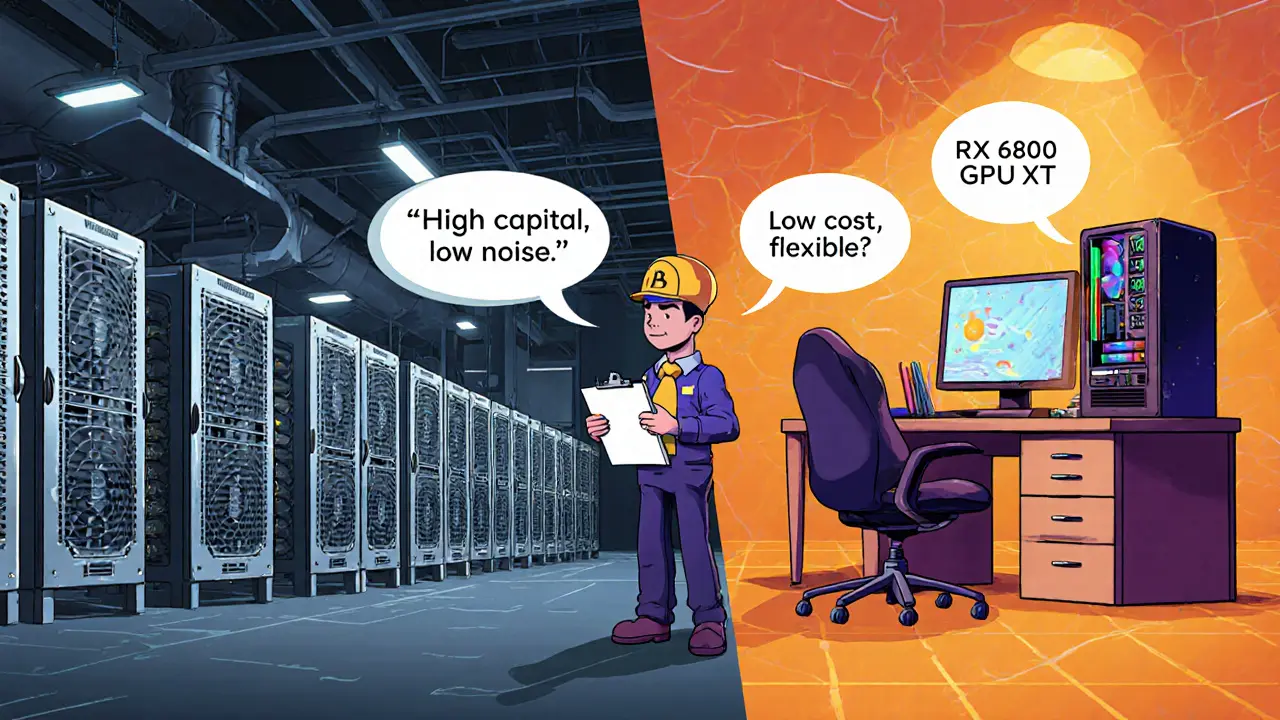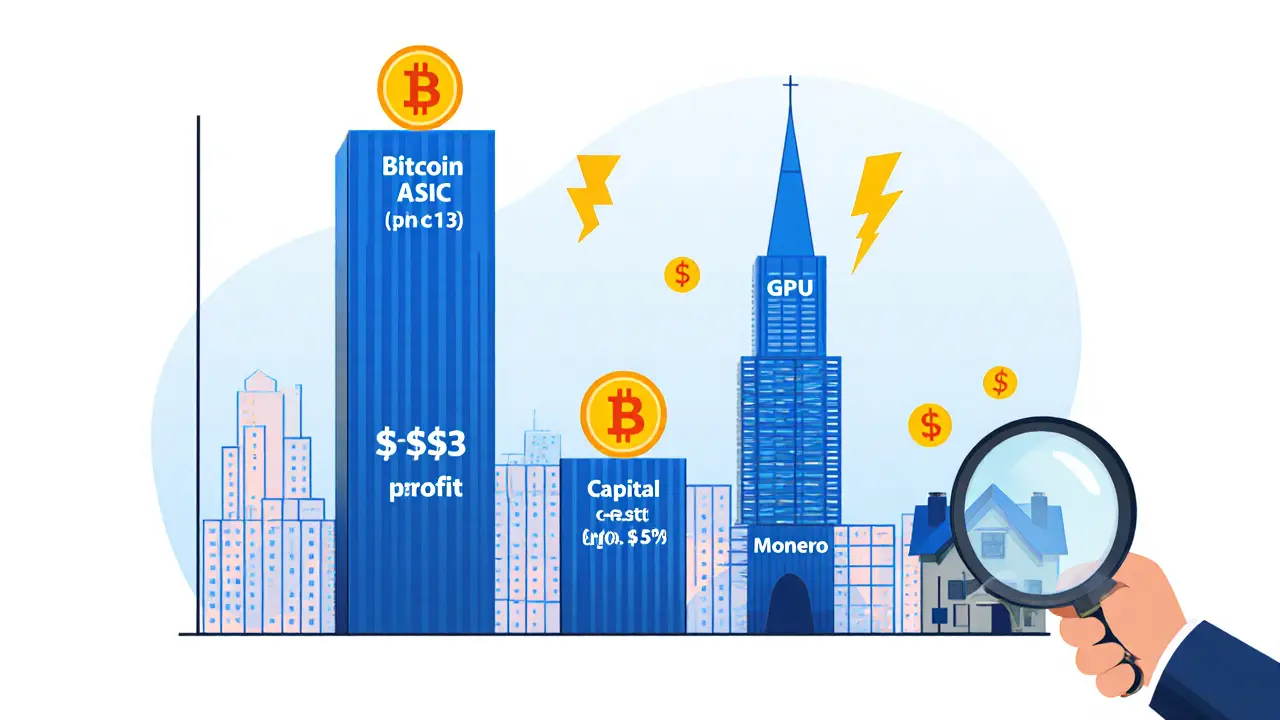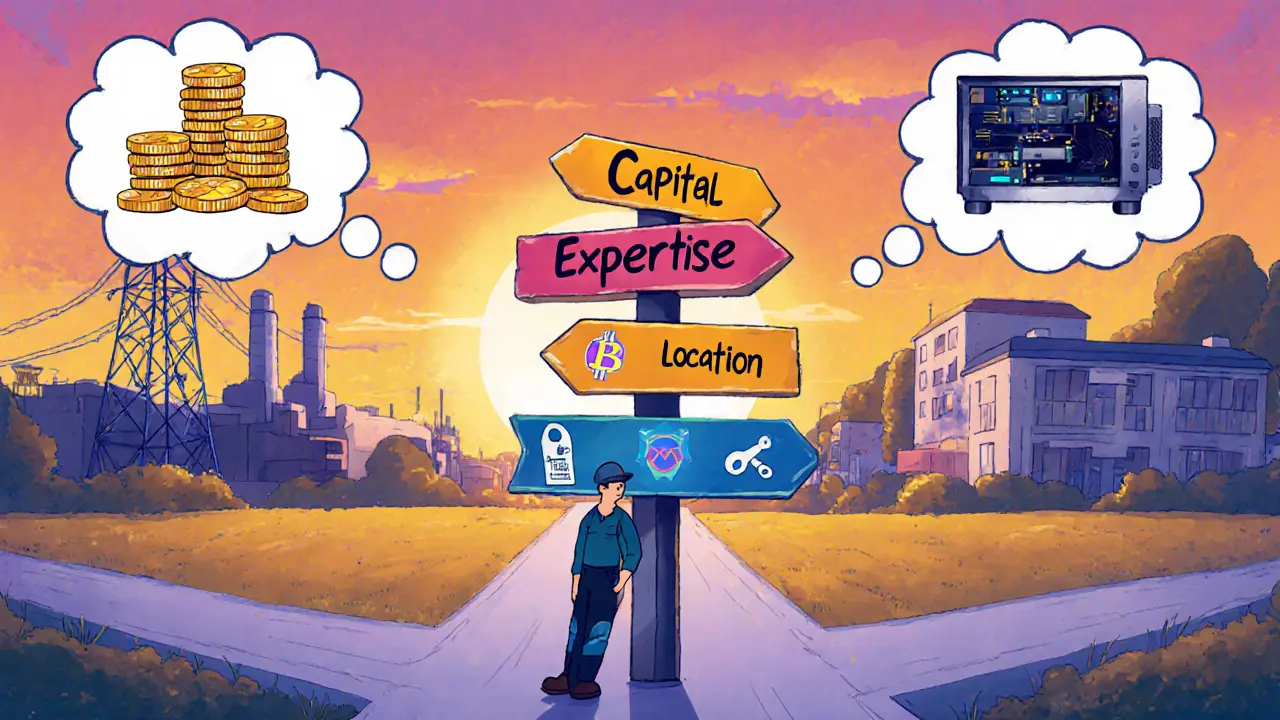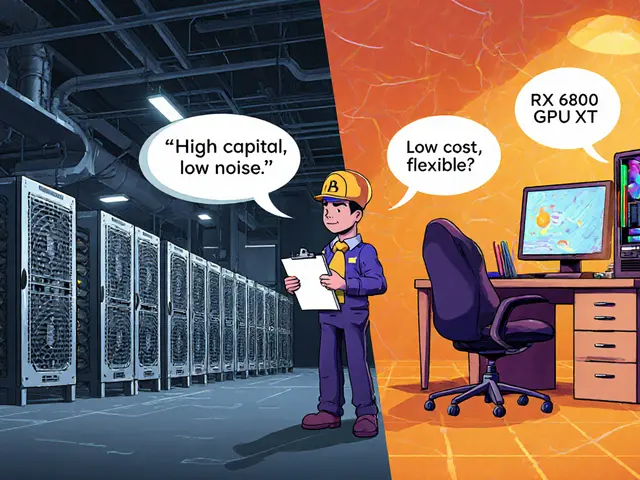Bitcoin vs Altcoin Mining: Profitability & Technical Guide 2025

Bitcoin vs Altcoin Mining Profitability Calculator
Mining Profitability Results
Enter values and click "Calculate Profitability" to see results.
Cryptocurrency mining is the process of securing a blockchain network by solving cryptographic puzzles, earning new coins and transaction fees in return. In 2025 the debate centers on whether to pour resources into Bitcoin mining or shift to altcoin mining. Both paths promise earnings, but the technical hurdles, capital outlay, and market volatility differ dramatically. This guide breaks down the key factors so you can decide which route aligns with your budget, skill set, and risk appetite.
1. Core Technical Differences
Understanding the hardware and consensus mechanisms is the first step before spending any dollars.
- Proof‑of‑Work (PoW) consensus: Bitcoin and most altcoins still rely on PoW, meaning miners must perform hash calculations to add a block.
- ASIC‑only vs. flexible hardware: Bitcoin requires Application‑Specific Integrated Circuit (ASIC hardware) that is designed solely for SHA‑256 hashing. Altcoins like Litecoin also use ASICs, but many-Monero, Zcash, Ethereum Classic-accept GPUs or even CPUs.
- Block time: Bitcoin’s block interval sits at 10 minutes, while Litecoin produces a block every 2.5 minutes and Monero every 2 minutes. Faster block times can translate to quicker reward cycles for miners.
These distinctions affect upfront costs, energy consumption, and the learning curve. ASIC machines deliver high hash rates but cost $8,000‑$15,000 each and demand specialized cooling. GPU rigs can be assembled for under $2,000, but they usually generate fewer hashes per watt.
2. Profitability Snapshot for 2025
Below is a side‑by‑side look at the most common mining choices as of September 2025. Numbers are averages drawn from industry reports (Bitdeer, Coin Bureau) and assume electricity rates of $0.06/kWh for Bitcoin and $0.07/kWh for most altcoins.
| Metric | Bitcoin | Litecoin | Monero |
|---|---|---|---|
| Typical hardware | Whatsminer M30S++ (ASIC, ~112 TH/s) | Goldshell LT6 (ASIC, ~2.5 TH/s) | RX 6800 XT GPU (≈30 MH/s) |
| Daily revenue (USD) | $12 - $18 | $5 - $9 | $3 - $6 |
| Power draw (kW) | 3.4 | 0.8 | 0.25 |
| Electricity cost (USD/day) | $4.90 | $1.34 | $0.42 |
| Net profit (USD/day) | $7 - $13 | $3 - $7.5 | $2.5 - $5.5 |
| Capital required (USD) | $10,000 - $30,000 | $1,500 - $3,500 | $500 - $1,500 |
| Difficulty trend 2024‑25 | ↑ 30% | ↑ 12% | ↑ 8% |
Bitcoin still delivers the highest absolute profit per unit of hardware, but the barrier to entry is steep. Litecoin offers a middle ground-lower cost ASICs and quicker block times-while Monero shines for hobbyists who can mine with existing gaming rigs.

3. Operational Realities
Beyond raw profit numbers, everyday management determines whether a mining venture survives the long haul.
- Electricity access: Large‑scale Bitcoin farms chase rates below $0.05/kWh, often securing deals with industrial utilities. Altcoin miners can survive at $0.07‑$0.09/kWh because their hardware draws less power.
- Cooling and noise: ASICs generate up to 3,500W of heat, demanding fans or liquid cooling. GPU rigs are quieter but still need decent airflow.
- Mining pool participation: For Bitcoin, joining a pool like F2Pool smooths payout variance. Altcoin pools (e.g., LitecoinPool.org, SupportXMR) have lower fees but also smaller total hash power.
- Regulatory landscape: Some jurisdictions treat Bitcoin mining as a heavy industrial activity, imposing reporting requirements. Altcoin mining, especially CPU‑based Monero, often escapes strict oversight but can attract scrutiny for privacy concerns.
Setting up a Bitcoin operation typically consumes 3‑6months of planning-site selection, electrical contracts, and hardware procurement. An altcoin rig can be up and running in a weekend using a personal computer.
4. Risk Profile and Market Dynamics
Profitability is not just about hardware efficiency; price volatility and network events play a big role.
- Halving impact: Bitcoin’s April2024 halving cut the block reward to 3.125BTC, slashing daily earnings for every miner. Altcoin reward schedules (e.g., Litecoin’s 6.25LTC) remain unchanged, giving them a relative edge post‑halving.
- Price correlation: Bitcoin’s price has steadied around $55k‑$60k, offering predictability for long‑term investors. Altcoins experience wider swings; a 30% price dip can wipe out a month’s profit for a Litecoin miner.
- Difficulty spikes: As hash rate climbs, difficulty follows. Bitcoin’s difficulty rose 30% in 2024‑25, whereas Monero’s slower growth (8%) keeps entry barriers low.
- Future protocol changes: Ethereum’s move to Proof‑of‑Stake eliminated its mining market entirely. While Bitcoin shows no sign of abandoning PoW, some altcoins are exploring hybrid models, which could shift hardware demands.
In short, Bitcoin offers more price stability but higher competition; altcoins provide quicker returns but expose miners to sharper market swings.

5. Strategic Takeaways
Use the following quick‑check guide to decide which path fits you:
- Capital available? If you can invest $10k‑$30k and secure cheap electricity, Bitcoin’s long‑term upside may justify the spend.
- Technical expertise? Beginners should start with GPU or low‑cost ASIC rigs for Litecoin or Monero to build confidence.
- Risk tolerance? Want stable, albeit slower, returns? Bitcoin is the safer bet. Comfortable with volatility? Altcoins let you flip profits faster.
- Location constraints? Rural areas with cheap power suit Bitcoin farms. Urban or home‑based miners typically stick to altcoins.
- Time horizon? If you plan to hold mined coins for years, Bitcoin’s market depth offers better liquidity. Short‑term traders may profit from altcoin price spikes.
Remember, mining success in 2025 hinges less on raw hash power and more on operational efficiency-electricity rates, cooling solutions, and pool selection. Keep an eye on network upgrades, regulatory news, and energy‑price trends to stay ahead of the curve.
Frequently Asked Questions
Is Bitcoin mining still profitable for a small investor?
Profitability is possible but tight. You need sub‑$0.06/kWh electricity, a modern ASIC, and a mining pool that offers low fees. Otherwise, daily net profit often falls below $5, making the ROI period several years.
Can I mine Monero with my gaming PC?
Yes. Monero’s RandomX algorithm is CPU‑friendly. A mid‑range Ryzen 7 or Intel i7 can generate $2‑$4 daily, and you only need to install XMRig software. No ASICs or special cooling are required.
How does Litecoin’s merged mining with Dogecoin affect earnings?
If you run a compatible Litecoin ASIC, the miner can submit shares to both the Litecoin and Dogecoin networks simultaneously. This adds a modest extra reward-usually 5‑10% of the Litecoin earnings-without extra electricity costs.
What’s the biggest hidden cost of Bitcoin mining?
Cooling. ASICs run hot, and without efficient airflow or liquid cooling you’ll see higher electricity bills and reduced hardware lifespan. Many miners allocate 30‑40% of their budget to HVAC solutions.
Should I join a mining pool or solo‑mine?
For Bitcoin, solo mining is nearly impossible unless you control tons of hash power. Altcoin pools are smaller, but joining one still smooths earnings and reduces payout variance. Solo mining is only sensible for hobbyists experimenting with CPU‑friendly coins.

Jack Stiles
Bitcoin mining's still a grind, but it can pay off if you got cheap power.
Ritu Srivastava
Prioritizing profit over the planet's health is indefensible; miners must seek renewable energy now.
Liam Wells
The author neglects to address the environmental externalities associated with ASIC production; moreover, the presented profitability tables omit depreciation costs; consequently, the analysis appears incomplete; a rigorous evaluation would incorporate such variables.
Caleb Shepherd
What most people don't realize is that the global energy giants quietly subsidize large‑scale Bitcoin farms, ensuring their dominance while small miners bleed electricity credits.
Darren Belisle
If you keep an eye on your electricity rates and choose the right hardware, you can turn mining into a reliable side hustle.
manika nathaemploy
Totally agree, the extra cash from a modest GPU rig for Monero helped cover my internet bill.
Mark Bosky
For anyone considering Bitcoin ASICs, focus on models with the best hash‑per‑watt ratio; the Whatsminer M30S++ currently offers around 33 J/TH, which translates to lower electricity costs and higher net margins.
Debra Sears
That's solid advice, Mark. I also recommend monitoring the firmware updates, as manufacturers often release efficiency patches that can boost performance.
Matthew Laird
Our country should champion Bitcoin mining as a strategic asset; by keeping the power grid under national control we can ensure fair rates for domestic miners.
Caitlin Eliason
The thrill of watching those hash rates climb is unmatched! 🌟 Watching each block reward hit the wallet feels like a personal victory.
Ken Pritchard
If you're new to mining, start by calculating your break‑even point using a reliable calculator, then experiment with a small rig before scaling up.